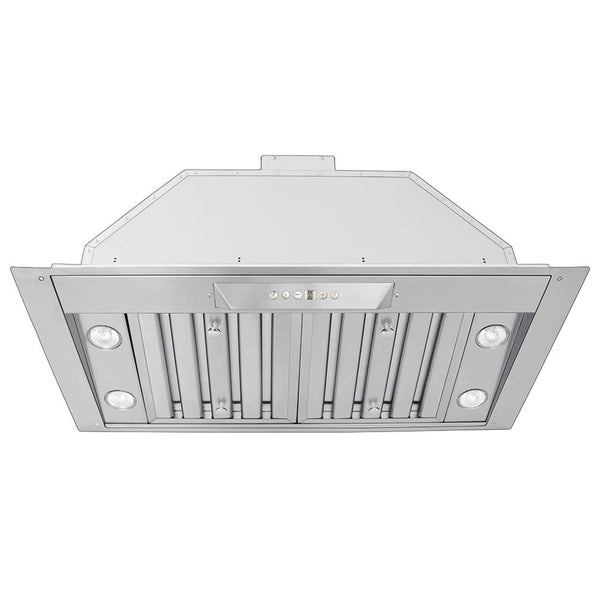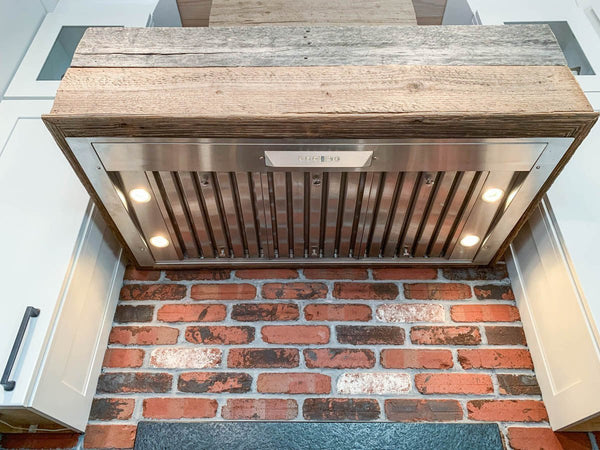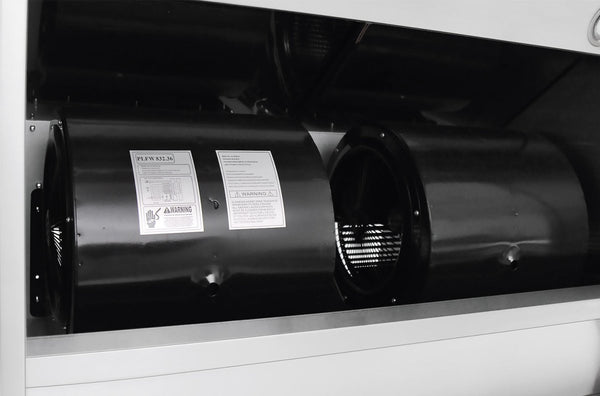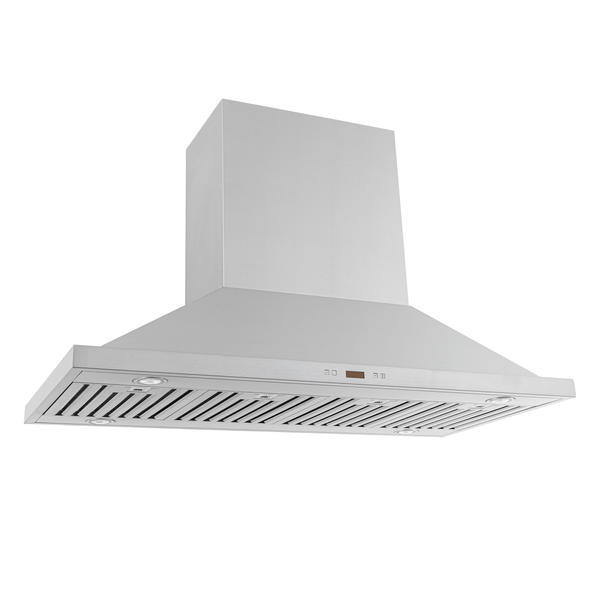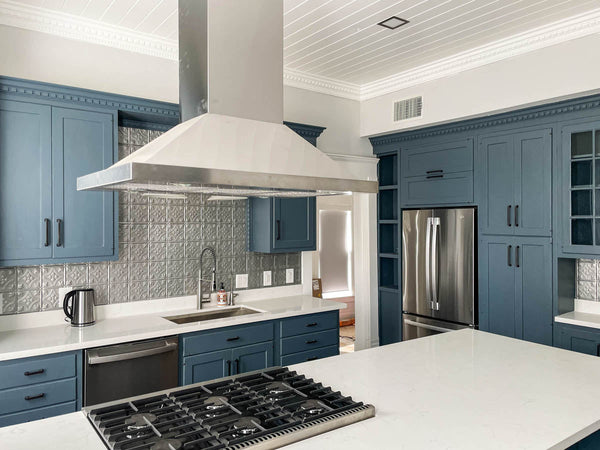Proline's Range Hood Buyers Guide
What is a Range Hood/Vent Hood?
A range hood, also called a vent hood, is your kitchen’s first defense against smoke, grease, and odors. Whether you’re searing steaks or simmering sauces, it pulls unwanted air out of your cooking space, keeping your kitchen fresh and your air clean.
Range hoods come in two main types:
- Ducted hoods – vent air outside for maximum efficiency.
- Non-ducted hoods – use charcoal filters to clean and recirculate air.
At Proline Range Hoods, we deliver factory-direct products that combine performance with style at an affordable price. Choose from sleek stainless steel, custom wood, or modern glass finishes. Every hood is engineered with:
- Powerful airflow to handle heavy cooking.
- Durable construction built to last.
- Easy installation so you can upgrade without the hassle.
With Proline, you’ll find the perfect fit for both your kitchen’s look and your cooking needs.
Are Range Hoods Necessary?
Cooking without proper ventilation doesn’t just leave your home smelling like last night’s dinner; it fills the air with smoke, grease, and particles that affect your health and comfort. That’s why the EPA and the International Residential Code recommend using a range hood to keep indoor air clean.
But ventilation is only part of the story. A quality hood also:
- Prevents grease buildup on cabinets and walls
- Makes cleaning easier with less residue and grime
- Reduces fire hazards by keeping flammable particles under control
At Proline Range Hoods, we’ve spent more than 17+ years perfecting the balance of powerful performance and stylish design. Whether you’re a casual cook or a culinary pro, a range hood isn’t just an accessory—it’s a must-have for a cleaner, safer, and more enjoyable kitchen.
Improving Indoor Air Quality
Cooking is essential, but it also releases pollutants that can harm indoor air quality. These include:
- Particulate Matter (PM)
- Volatile Organic Compounds (VOCs)
- Nitrogen Dioxide (NO₂)
- Carbon Monoxide (CO)
These pollutants are produced by both cooking methods and the fuel used. For example:
- Frying releases high levels of PM and VOCs.
- Gas stoves produce NO₂ and CO.
A Proline Range Hood helps improve air quality by:
- Capturing and removing airborne contaminants at the source.
- Utilizing powerful motors and efficient capture areas to clear the air.
A range hood is a necessity when keeping your kitchen safe and comfortable for your family.
Proline's Blog Posts Resources
- Why Are Range Hoods Necessary?
- Health Risks or Not, Why You Need a Ducted Range Hood Over Your Gas Range
- Do Range Hoods Have To Be ADA Compliant?
Other Great Resources
Fire Prevention
Range hoods are essential for fire safety by:
- Removing flammable grease particles, smoke, and heat generated during cooking.
- Preventing grease buildup, which lowers the risk of kitchen fires.
At Proline, we enhance fire prevention with:
- Long-lasting baffle filters that trap grease effectively.
- Powerful blowers that ensure optimal performance.
- Regular cleaning and maintenance to keep your hood performing safely and efficiently.
Range Hoods Are Required by Law in Some States
While the International Residential Code (IRC) offers general guidelines for ventilation, local building codes can vary significantly. In some jurisdictions, installing a kitchen vent hood is mandated by law. Proline is committed to helping you navigate these requirements. Our team is always available to provide support and resources to make your range hood purchase and installation process as smooth as possible.
States with Range Hood Requirements:
California, Massachusetts, New York, Texas, Florida, Virginia
Range Hood Features and Benefits
When shopping for a range hood, keep in mind the following features that distinguish our Proline models:
- Airflow (CFM): This is the power behind your ventilation. Measured in cubic feet per minute, this determines how quickly and effectively the hood ventilates your kitchen. Proline’s range of CFM ratings—from 600 to 2000—ensures there’s a perfect model for every cooking style.
- Exhaust Timer: An automated timer that shuts off your exhaust fan, saving energy while keeping the air clean.
- Filters: Our stainless steel baffle filters are dishwasher-safe, making cleanup simpler. We also offer additional filter options for specialized needs.
- Number of Fan Speeds: Multiple speeds let you customize ventilation power depending on your cooking intensity.
- Size: We offer hoods ranging from 24” to 72”. We recommend choosing a hood at least as wide as your cooking surface for optimal air capture.
- Style: Proline’s signature look blends form and function. Choose from stainless steel, copper, tempered glass, wood, zinc, or bronze—whatever suits your décor.
What sets us apart? Our factory-direct model means you get premium materials and expert craftsmanship—without the extra markup.
How to Choose Among Different Types of Range Hoods
At Proline, we pride ourselves on providing the largest variety of range hoods in the market—perfect for every style, kitchen layout, and cooking need. When choosing the right range hood, consider your cooking setup, your kitchen design, and the level of ventilation required.
Wall-Mounted Range Hoods
- Best for kitchens with a range against a wall.
- Efficient ducting with shorter exhaust paths.
- Available in sizes from 24” to 60”.
- High CFM motors for powerful ventilation.
- Stylish stainless steel finishes and optional LED lighting.
Under-Cabinet Range Hoods
- Perfect for kitchens with limited space.
- Fits neatly beneath existing cabinetry.
- Available in sizes from 30” to 72”.
- Advanced motors and dishwasher-safe filters for easy cleaning.
Island Range Hoods
- Ideal for open-concept kitchens with island cooktops.
- Higher CFM models to handle smoke and odors.
- Customizable finishes and lighting for added style.
Insert/Liner Range Hoods
- Great for custom-built enclosures or specific designs.
- Fits 30” to 60” spaces.
- Strong motors to handle any cooking level.
- Easy to install, trusted by professionals and DIYers alike.
Shop Range Hoods by Type
Choosing the Right Size
A rule of thumb: choose a hood at least six inches wider than your cooktop to capture smoke and grease effectively. Proline offers an extensive range of widths, ensuring you’ll find just the right fit for your kitchen or outdoor setup.
What size of range hood do you need?
Outdoor Range Hoods
Outdoor kitchens demand reliable, weather-resistant ventilation. Proline offers premium 304 stainless steel models, perfect for patios and BBQ islands. This marine-grade stainless steel resists corrosion and stands the test of time, especially in humid or coastal areas. For the dedicated grilling enthusiast, we recently introduced the BBQ Ultra and BBQ Pro Series, ranging from 42” to 72,” featuring:
- High CFM Motors: Up to 2000 CFM for tackling intense grilling smoke
- Extra-Wide Coverage: Ideal for covering large BBQ grills
- Rugged Design: Built to withstand outdoor conditions while maintaining aesthetic appeal
With 17 years in the range hood business we are the first to have a specialized range hood for a BBQ. These are designed for some serious heat and smoke while you maintain that sleek, stylish look.
Installation Considerations
Whether you’re a seasoned DIYer or hiring a professional, keep these points in mind:
- Ducting: Whenever possible, duct your hood to the outside. This is the most efficient way to maintain excellent air quality. If external ducting isn’t feasible, Proline’s convertible hoods support ductless installation with charcoal filters.
- Mounting: Depending on your layout, your hood can be wall-mounted, installed under cabinetry, or included in a custom canopy. Choose an approach that complements your kitchen’s flow.
- Size: Ensure your hood is at least as wide as your cooking surface for best ventilation.
- Style: From modern stainless steel to rustic wood, Proline has designs to fit every kitchen theme.
What is Ducting, and Which Type with Charcoal Filters Do You Need?
Ducting channels the cooking exhaust outside your home, ensuring grease and odors don’t linger in your kitchen. Proline offers powerful ducted models that use aluminum or stainless steel baffle filters to trap grease, then vent it outdoors.
If you can’t install exterior ductwork, our convertible range hoods make ductless ventilation possible. We offer specialized recirculating kits and charcoal filters for under-cabinet, wall, or island-mounted hoods. This flexibility means you can still enjoy Proline’s powerful ventilation, even if you aren’t able to vent your kitchen air outside.
Why Ducting Size Is Important
Your duct’s diameter and configuration affect airflow. Even a high-powered hood won’t perform optimally if the ducts are too narrow or have too many bends. If you’re not sure which duct size is best for your project, our dedicated support team at Proline can guide you through the process, ensuring you get maximum efficiency from your range hood.
Range Hood Duct Size Calculator
Find the optimal duct size for your hood setup.
How Many CFM (How Strong) Does Your Range Hood Need to Be?
CFM requirements depend on three factors: type of cooktop, kitchen size, and cooking habits.
- Electric Cooktops: Multiply the cooktop width by 10. For a 36” stove, you need at least 360 CFM.
- Gas Ranges: Add the total BTUs of all burners and divide by 100. For 50,000 BTUs, you need 500 CFM.
- Outdoor Grills: Generally follow the same formula as gas ranges but be mindful that grills often have higher BTUs. Our BBQ Pro Series hoods deliver up to 2000 CFM for heavy-duty outdoor cooking.
Kitchen size matters, too. Multiply the room’s length, width, and height, then divide by 4. Compare that figure to the calculated CFM needed for your stove—whichever is larger is the CFM you should choose. For serious or frequent cooking, opt for a higher CFM for added flexibility.
Range Hood Calculator: How Many CFM Do You Need?
To determine how many CFM (cubic feet per minute) you need, you’ll need to consider several factors, including the size of your kitchen, the type of cooking you do, and the power of your range. Here’s a simple calculator to help you determine your CFM needs:
- Measure Your Kitchen: Measure the length, width, and height of your kitchen in feet. Multiply these dimensions to get the volume of your kitchen in cubic feet.
- Calculate Minimum CFM: Divide the volume by 8 to get the minimum CFM required to replace the air in your kitchen 8 times per hour. This ensures adequate ventilation for a typical kitchen.
- Consider Cooking Habits: Consider the type of cooking you do and the power of your range. If you do a lot of heavy cooking or have a high-powered range, you may need a higher CFM. For example, gas ranges typically require more ventilation than electric stoves due to higher heat output.
- Account for Ductwork: Add 10-20% to the calculated CFM to account for any obstacles or inefficiencies in the ductwork. This ensures your range hood can handle any potential airflow restrictions.
By following these steps, you can determine the appropriate CFM for your range hood, ensuring effective ventilation and a comfortable cooking environment.
Range Hood CFM Calculator
Cooktop-Based Calculation
Step 1: Cooktop Selection
Step 2: Cooking Styles
Step 3: Ductwork Adjustments (Optional)
Kitchen Air Exchange Calculation
Noise Reduction Solutions
Proline understands the importance of a quiet kitchen. Here are some noise-reducing options to consider:
- Edge/Perimeter Air Drawing: Enhances efficiency and cuts down on noise. Downdraft vents pull rising smoke downward, reducing both noise and smoke capture.
- Testing Noise Levels: Test our range hoods in a showroom, or check Proline’s detailed product descriptions and customer reviews for insights.
- External or In-Line Blowers: Placing the blower away from the kitchen helps minimize noise.
We continuously refine our products to minimize noise without sacrificing performance. With a Proline Range Hood, you’ll enjoy a cleaner, quieter kitchen.
Range Hood Maintenance and Upkeep
Regular maintenance is essential to ensure the longevity and performance of your range hood. Here are some tips to help you keep your range hood in top condition:
- Clean the Filters Regularly: Depending on the type of filter, you may need to wash or replace them every 1-3 months. Stainless steel baffle filters, for example, are dishwasher-safe and easy to clean. Check your user manual for specific instructions to keep your filters functioning efficiently.
- Clean the Exterior: Use a soft cloth and mild detergent to wipe down the exterior of the range hood. Avoid using abrasive materials or harsh chemicals that can damage the finish. Regular cleaning will keep your hood looking new and prevent the buildup of grease and grime.
- Check and Replace the Grease Trap: If your range hood has a grease trap, check it regularly and replace it when necessary. A clogged grease trap can reduce the performance of your range hood and increase the risk of fire hazards.
- Check the Ductwork: For ducted range hoods, inspect the ductwork periodically to ensure it is clear of debris and blockages. Proper airflow is crucial for effective ventilation, so keeping the ducts clean is essential.
- Schedule Annual Maintenance: Consider hiring a professional to inspect and maintain your range hood annually. A professional can check for any issues and ensure your hood is working efficiently and effectively, giving you peace of mind.
By following these maintenance tips, you can ensure your range hood continues to perform at its best, keeping your kitchen clean and safe.
Proline's Resources
Range Hood Buying Tips
When shopping for a range hood, consider these key factors to find the right one for your kitchen:
- Set Your Budget: Range hoods come in a variety of prices. Know your budget to narrow down your options and get the best value for your needs.
- Choose the Right Size: The hood should be at least as wide as your cooktop for optimal airflow. Avoid choosing one that’s too small or too large.
- Pick a Style: Whether modern or traditional, select a range hood that matches your kitchen’s aesthetic. From sleek stainless steel to custom wood designs, there’s something for every style.
- Check the Features: Look for the features you need, like variable speed, exhaust timers, and easy-to-clean filters. Proline offers options to suit your needs.
- Read Reviews: Check customer reviews for feedback on performance and potential issues. They can help you make a well-informed decision. By following these tips, you’ll find the perfect range hood that fits your needs and enhances your kitchen.
Range Hood Styles and Designs
Range hoods come in various styles to fit different kitchen layouts and designs. Here are some popular options:
- Wall Mount Hoods: Mounted directly to the wall, these are perfect for kitchens with limited cabinet space. Available in finishes like stainless steel and glass, they combine style and function.
- Island Hoods: Ideal for island cooktops, these wider hoods cover the entire cooking surface and come with powerful motors to handle smoke and odors in open kitchens.
- Downdraft Hoods: Great for small kitchens, these hoods mount to the cooktop and retract when not in use, keeping your kitchen’s view clear.
- Over-the-Range Microwaves: A space-saving option that combines a microwave with a range hood, offering convenience and effective ventilation in one.
- Hood Inserts: These fit into custom cabinetry, offering a sleek, integrated look without sacrificing performance.
- Ductless Hoods: Perfect for kitchens without ductwork, these hoods filter and recirculate air, providing flexibility and effective ventilation.
By understanding the different styles, you can choose the range hood that fits your kitchen’s layout and design needs.
- Choosing a selection results in a full page refresh.
